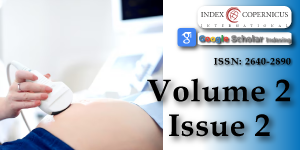Correlation between the presence of maternal gestational or pre-gestational pathologies and hearing impairment in the puerperal period
Main Article Content
Abstract
Objective: To evaluate whether the occurrence of maternal pathologies, mainly Diabetes Mellitus and Hypertensive Syndromes in the gestational or pre-gestational period may be related to hearing impairment in postpartum women.
Methods: Observational, prospective study including 361 puerperal women who had their deliveries at a reference University Hospital for pregnant women with clinical history of risk. Auditory evaluation was performed by Distortion Product Otoaccoustic Emissions (DPOAE) within 14 days after delivery. Measures of central tendency and absolute and relative frequencies were used to describe the sample and the chi-square test and binary logistic regression to assess the correlation among variables. Significance higher than 95% was observed and the study was approved by the Research Ethics Committee.
Results: A total of 361 postpartum women were studied and 7.5% had hearing impairment. The frequency of gestational hypertension was 13.9%, that of gestational diabetes was 8.6% and that of pre-pregnancy diabetes mellitus was 5.8%. The presence of hearing impairment was significantly correlated with the occurrence of pre-pregnancy diabetes mellitus (OR: 4.5 - CI: 1.51-1.47), and maternal age greater than 29 years (OR: 3.72 - 1, 58-8.76); A correlation was also found between maternal age and the presence of pre-pregnancy diabetes mellitus (OR: 3.84 - CI: 1.45-10.15).
Conclusion: In the population of postpartum women evaluated, having Diabetes Mellitus prior to pregnancy and belonging to the age group older than 29 years increases the chance of having hearing loss.
Article Details
Copyright (c) 2019 Simen RCM, et al.

This work is licensed under a Creative Commons Attribution 4.0 International License.
Baylan MY, Kuyumcuoglu U, Kale A, Celik Y, Topcu I. Is preeclampsia a new risk factor for cochlear damage and hearing loss? Otol Neurotol. 2010; 31: 1180-1183. PubMed: https://www.ncbi.nlm.nih.gov/pubmed/20657326
Oh IH, Lee JH, Park DC, Kim M, Chung JH, et al. Hearing loss as a function of aging and Diabetes Mellitus: A Cross Sectional Study. PLoS ONE. 2014; 9: e116161. PubMed: https://www.ncbi.nlm.nih.gov/pubmed/25549095
Altuntas EE, Yenicesu AGI, Mutlu AE, Muderris S, Cetin M, et al. An evaluation of the effects of hypertension during pregnancy on postpartum hearing as measured by transient-evoked otoacoustic emissions. Acta Otorhinolaryngol Ital. 2012; 32: 31-36. PubMed: https://www.ncbi.nlm.nih.gov/pubmed/22500064
Selcuk, Terzi H, Turkay U, Kale A, Genc S. Does gestational diabetes result in cochlear damage? J Laryngol Otol. 2014; 128: 961-965. PubMed: https://www.ncbi.nlm.nih.gov/pubmed/25399828
Brant LJ, Gordon-Salant S, Pearson JD, Klein LL, Morrell CH, et al. Risk factors related to age-associated hearing loss in the speech frequencies. J Am Acad Audiol. 1996; 7: 152-160. PubMed: https://www.ncbi.nlm.nih.gov/pubmed/8780987
Cilento BW, Norton SJ, Gates GA. The effects of aging and hearing loss on distortion product otoacoustic emissions. Otolaryngol Head Neck Surg. 2003; 129: 382-389. PubMed: https://www.ncbi.nlm.nih.gov/pubmed/14574293
Abdala C, Dhar S. Maturation and Aging of the Human Cochlea: A View through the DPOAE Looking Glass. J Assoc Res Otolaryngol. 2012; 13: 403-421. PubMed: https://www.ncbi.nlm.nih.gov/pubmed/22476702
Bakhshaee M, Hassanzadeh M, Nourizadeh N, Karimi E, Moghiman T, et al. Hearing impairment in pregnancy toxemia. Otolaryngol Head Neck Surg. 2008; 139: 298-300. PubMed: https://www.ncbi.nlm.nih.gov/pubmed/18656733
Linssen AM, van Boxtel MP, Joore MA, Anteunis LJ. Predictors of Hearing Acuity: cross sectional and Longitudinal analysis. J Gerontol A Biol Med Sci. 2014; 69: 759-765. PubMed: https://www.ncbi.nlm.nih.gov/pubmed/24149430
Jáuregui-Renaud K. Diabetes mellitus in the inner ear. Eur J Pharm Med Res.2016; 3: 17-22.
Hou Y, Xiao X, Ren J, Wang Y, Zhao F. Auditory Impairment in Young Type 1 Diabetics. Arch Med Res. 2015; 46: 539-545. PubMed: https://www.ncbi.nlm.nih.gov/pubmed/26385484
Lasagni A, Giordano P, Lacilla M, Raviolo A, Trento M, et al. Cochlear, auditory brainstem responses in Type 1 diabetes: relationship with metabolic variables and diabetic complications. Diabet Med. 2016; 33: 1260-1267. PubMed: https://www.ncbi.nlm.nih.gov/pubmed/26605750
Jacob TA, Soares LR, Santos MR, et al. Gestacional Diabetes Mellitus: a literature review. Braz J Surg Clin Res. 2014; 6: 33-37.
Esparza CM, Jáuregui-Renaud K, Morelos CM, Muhl GE, Mendez MN, et al. Systemic high blood pressure and inner ear dysfunction: a preliminary study. Clin Otolaryngol. 2007; 32: 173-178. PubMed: https://www.ncbi.nlm.nih.gov/pubmed/17550504
Soares MA, Sanches SG, Matas CG, Samelli AG. The audiological profile of adults with and without hypertension. Clinics. 2016; 71: 187-192. PubMed: https://www.ncbi.nlm.nih.gov/pubmed/27166767
Hull RH, Kerschen SR. The influence of cardiovascular health on peripheral and central auditory function in adults: a research review. Am J Audiol. 2010; 19: 9-16. PubMed: https://www.ncbi.nlm.nih.gov/pubmed/20538964
Lisowska G, Namysowski G, Morawski K, Strojek K. Early identification of hearing impairment in patients with type 1 diabetes mellitus. Otol Neurotol. 2001; 22: 316-320. PubMed: https://www.ncbi.nlm.nih.gov/pubmed/11347633
Dayem SM Abd El, Ghany SM Abd El, Beshr Amal E, Hassan AG, Attaya MS. Assessment of hearing in children with type 1 diabetes mellitus. J Pediatr Endocrinol Metab. 2014; 27: 393-402. PubMed: https://www.ncbi.nlm.nih.gov/pubmed/24572980
Kim MB, Zhang Y, Chang Y, Ryu S, Choi Y, et al. Diabetes mellitus and the incidence of hearing loss: a cohort study. Int J Epidemiol. 2017; 46: 717-726. PubMed: https://www.ncbi.nlm.nih.gov/pubmed/27818377
Iser BPM, Stopa SR, Chueiri PS, et al. Prevalence of self-reported diabetes in Brazil: results from the National Health Survey 2013. Epidemiol Serv Saude. 2015; 24: 305-314.
Milech A, Oliveira JEP, Vencio S, et al. Basic Principles, Evaluation and Diagnosis of Diabetes Mellitus. In Guidelines of the Brazilian Society of Diabetes (2015-2016). São Paulo; AC Farmacêutica. 2016; 1-122.
Brazil. Ministry of Health. Health Surveillance Systems. VIGITEL: Surveillance of Risk Factors and Protection for Chronic Diseases by Telephone Survey. 2013.
Structure by age and gender of the disabled population. IBGE 2010 Population Census - General characteristics of population, religion and persons with disabilities.
Engdahl B. Otoacoustic emissions in the general adult population of Nord-Trondelag, Norway: I. Distributions by age, gender, and ear side. Int J Audiol. 2002; 41: 64-77. PubMed: https://www.ncbi.nlm.nih.gov/pubmed/12467372
Bonfils P, Bertrand Y, Uziel A. Evoked Otoacoustic Emissions: normative data and presbycusis. Audiology.1988; 27: 27-35. PubMed: https://www.ncbi.nlm.nih.gov/pubmed/3377724
Collet L, Moulin A, Gartner M, Morgon A. Age-related changes in evoked otoacoustic emissions. Ann Otol Rhinol Laryngol. 1990; 99: 993-997. PubMed: https://www.ncbi.nlm.nih.gov/pubmed/2244732
Bittar RSM, Sanchez TG, Santoro PP, et al. Glucose metabolism and inner ear. Int Arch Otorhinolaryngology. 1998; 2: 39-42

